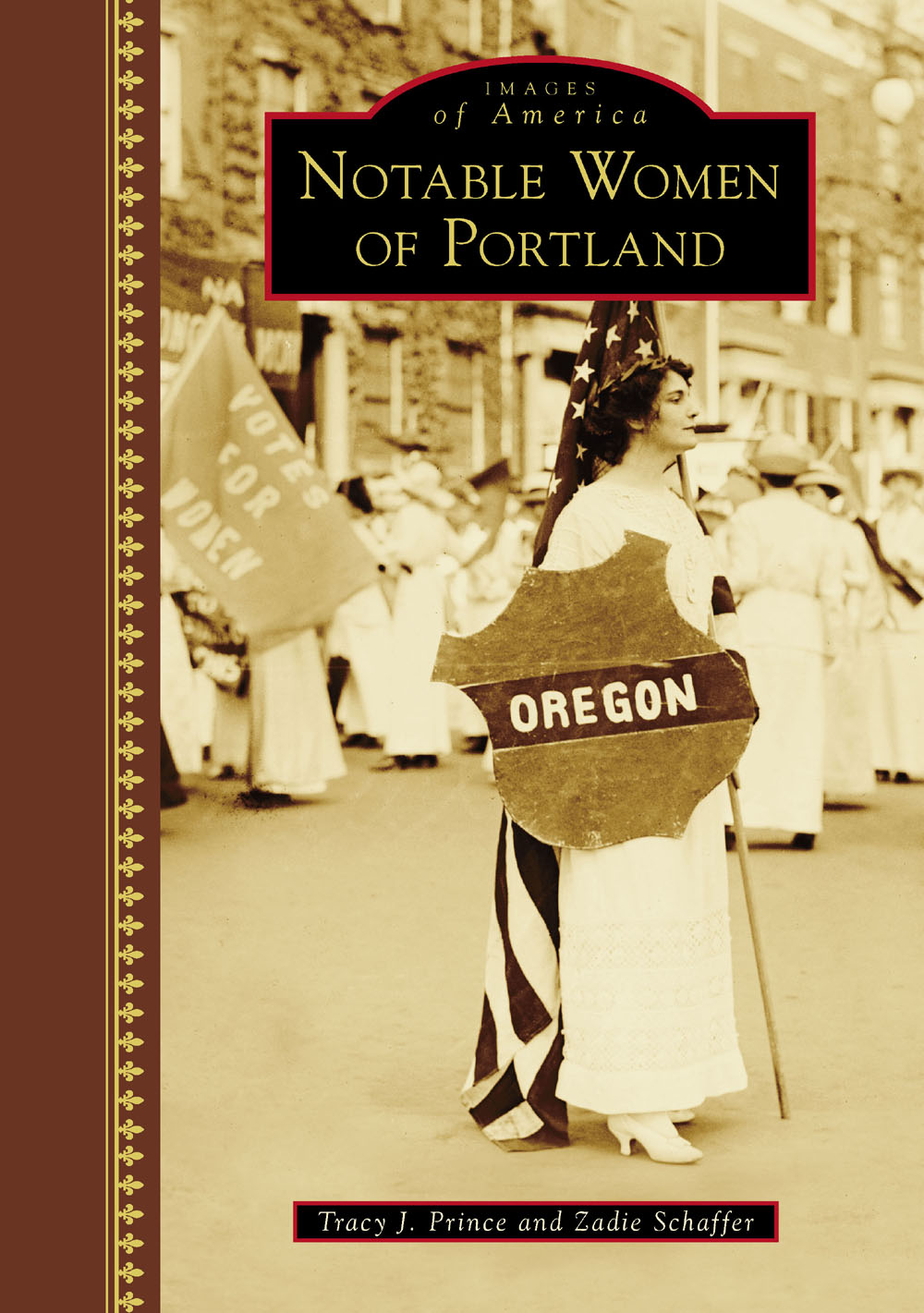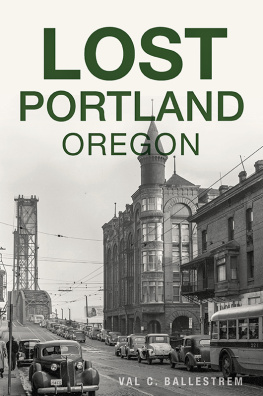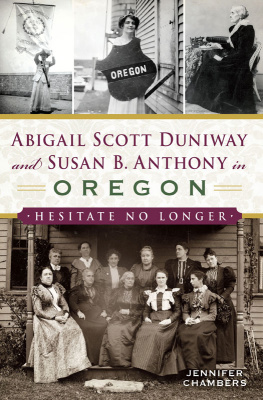
IMAGES
of America
NOTABLE WOMEN
OF PORTLAND

In 1905, Portland hosted the National American Woman Suffrage Association Convention. Attendees are pictured at the Lewis and Clark Expositions Oregon Building at a reception for Susan B. Anthony (center). Abigail Scott Duniway is to her right (with the crossed scarf), and Dr. Marie Equi is directly behind her on the left. The Oregon suffrage vote failed five times before male voters finally gave women the right to vote in 1912. (OHS 59438.)
ON THE COVER: Margaret Vale Howe, Pres. Woodrow Wilsons niece, holds the shield representing the Oregon delegation at a 1913 womans suffrage march in Washington, DC. She was not an Oregonian, but as an actress from a prominent family she was one of the suffrage movement women carrying shields of states that had already won womens suffrage. In 1912, Oregon became the ninth state to approve womens right to vote. (Library of Congress.)
IMAGES
of America
NOTABLE WOMEN
OF PORTLAND
Tracy J. Prince and Zadie Schaffer

Copyright 2017 by Tracy J. Prince and Zadie Schaffer
ISBN 978-1-4671-2505-5
Ebook ISBN 9781439661208
Published by Arcadia Publishing
Charleston, South Carolina
Library of Congress Control Number: 2017935225
For all general information, please contact Arcadia Publishing:
Telephone 843-853-2070
Fax 843-853-0044
E-mail
For customer service and orders:
Toll-Free 1-888-313-2665
Visit us on the Internet at www.arcadiapublishing.com

This book is dedicated to the women who paved the way before us. To Shirley Prince, who read Miss Manners books with the idea that very good manners (and lots of library time) would give her children a much less chaotic and impoverished life than she had. She was rightexcellent manners and a lot of reading go a long way in this world. To Susan Schaffer, who, in 1975, wrote this letter to the editor of her hometown Oklahoma newspaper asking them to stop using only the names of husbands to identify women. When she read a name like Mrs. John Doe, she did not know what the first name was. She was new to town and wanted to know their names. The Bartlesville Examiner-Enterprise changed its policy. And to generations of our grandmothersLois Prince, Chessie Dale Prince, Lucinda Priest, June Marie McBride, Rosetta Cason, Mattie McBride, Sarah Schaffer, Machna Schaffer, Sprintza Toback, Ruth Kramer, Nettie Singer, and Rachel Kramerall women who longed for better opportunities for their daughters than the times they lived in.
CONTENTS
ACKNOWLEDGMENTS
We are deeply indebted to our dear friend Norm Gholston, who so graciously allowed the use of many images from his vast private collection.
We appreciate the archivists who helped so much, especially Meg Langford, Oregon Health Sciences University; Julie Yamaka, Oregon Blue Book at Oregon State Archives; and Cris Paschild and Carolee Harrison, Portland State University.
Image credit is abbreviated as follows: City of Portland Archives (CoPA), Gholston Family Collection (Gholston), Library of Congress (LOC), Doug Magedanz (Magedanz), New York Public Library (NYPL), Oregon Cultural Heritage Commission (OCHC), Oregon Health Sciences University Historical Collections and Archives (OHSU), Oregon Historical Society (OHS), Oregon Jewish Museum and Center for Holocaust Education (OJM), Oregon State Archives (OSA), Oregon State University Archives (OSU), Portland Art Museum (PAM), Portland State University Archives (PSU), Reed College Special Collections, Eric V. Hauser Library (Reed), San Francisco Bay Area Television Archives (SFBATA), Archives of the Sisters of the Holy Names of Jesus and Mary, U.S.Ontario Province (Sisters), Triangle Productions for Gracie Hansen books (trianglepro.org), University of Oregon Archives (UofO), University of Portland Athletics (UP), Wikimedia Commons (W), and Willamette Universitys Ruth Dennis Grover Papers_III_4_8, Pacific Northwest Artists Archive (WU). All images not cited are photographs in our collection.
We most appreciate support from our family, Scott Schaffer and Price Schaffer, who cheered us on, posed for pictures, and were very patient with the enormous amount of time involved in writing this book.
All proceeds will benefit women in crisis at the Safety Off the Streets and Jeans Place shelters, part of Transition Projects.
INTRODUCTION
The story of Portland, Oregon, like much of history, is usually told with a focus on mens stories. This book tells about some of the women who made Portland what it is today. Their stories inspire us, make us want to understand the social norms they were living in, and help to more accurately reframe Portlands history. An example of how womens erased history needs to be restored is that many historians wrote about William Johnson, a British sailor who settled in what became the South Waterfront and Lair Hill neighborhoods. He was described as having an Indian wife, but historians never mentioned her name. It took incredible sleuthing by researcher Ginny Mapes to uncover records showing that her name was Polly. Then there is Etienne Lucier, who is described as the first white resident of what became East Portland; but his Native wife, Josette Nouette, who lived there too, is rarely mentioned. Portland pioneers whose surnames are on land records and street names, Charlotte Terwilliger and Minerva Carter, have been mostly lost to history though they were prominent in their time.
For millennia, thousands of Native American women lived in and passed through what became Portland. Several Chinook Indian bands (including the Multnomah, Cascade, and Clackamas) had permanent villages at the site of what is now Portland. But other tribes passed through and lived here seasonally, including the Tualatin, Kalapuya, Molalla, and Klickitat. Glimpses of this long history of Native American women are shown in disproves historian assumptions that what became Old Portland (originally just the inner west side along the Willamette) did not have a pre-1840s history of Native Americans other than occasional stops at The Clearing. The carved seal found on the South Park Blocks indicates a larger habitation area for earlier Native people.
Historians also depict post-1840s Portland as being devoid of Native Americans. This is incorrect. This book works to more accurately tell the history of early Portlands Native American women. The reality is that pioneers and Native Americans interacted frequently, often living next to each other (see ).
Progressive Era women in worked for suffrage, temperance, prohibition, sanitation, free libraries, and protecting women and childrens labor. Known as Portlands first woman physician, Mary Anna Cooke Thompson came to Oregon in 1866 with her husband and children via the Panama Canal. She spoke to the National Woman Suffrage Association Convention in Washington, DC, and before the US Senate and lobbied Pres. Rutherford B. Hayes on suffrage. The first female lawyer in Oregon, Mary Gysin Leonard, was known for courtroom expertise, hard drinking, and giving free legal advice to ladies of the night. Women working in the suffrage movement such as Abigail Scott Duniway, Dr. Marie Equi, Lizzie Weeks, Sara Bard Field, and many others worked tirelessly for womens right to vote.
Next page








